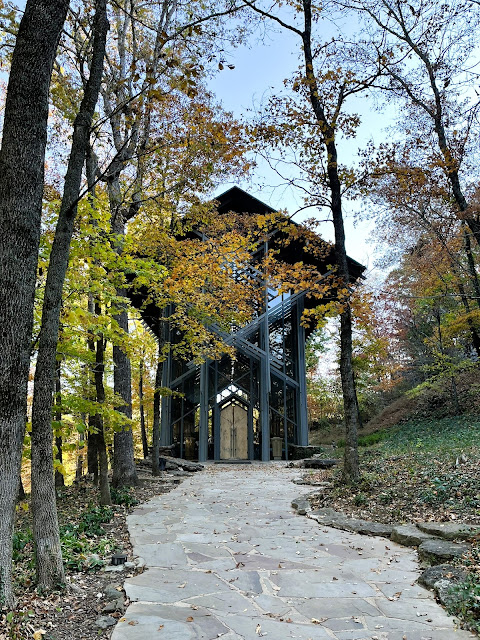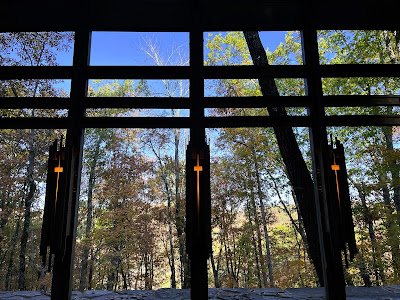My first-ever school solo was a song called, "I Know a Green Cathedral." While I sometimes can't remember why I walked into a room, I still remember the words to that song. It says, in part:
Though the "green cathedral" was starting to be touched by fall colors, I couldn't help but think of the song as we visited the Thorncrown Chapel in Eureka Springs, Ark.
Someday, Randy wants to go to the eastern part of the U.S. in the fall to join other ubiquitous "leaf peepers." I'm not opposed to the idea, but it seemed we'd just gotten home from a long trip to Glacier, Yellowstone and Grand Teton National Parks. Plus, how do you guess the optimum time for leaf "peeping?"
I threw out the idea to go to the Ozarks, a much closer destination that's also known for viewing fall foliage. We could get there in a day, which appealed to both of us. And Brent and Susan had enjoyed a trip to Eureka Springs a couple years ago, so that was where my vacation planner (AKA Randy) decided for us to headquarter.
The fall foliage was muted, thanks to the same drought that has plagued our area. But we still enjoyed our time in the Ozarks. Thorncrown Chapel was one "must-do" stop for me in Eureka Springs. I've seen beautiful engagement and wedding photos taken there, so I wanted to see the unique chapel for myself. It lived up to the hype.
Thorncrown Chapel was the dream of Jim Reed, a native of Pine Bluff, Ark. In 1971, Jim purchased the land which is now the site of the chapel to building his retirement home. However, other people admired the location and would often stop at his property to gain a better view of the Ozark hills. Instead of fencing them out,Jim chose to invite in by building a glass chapel in the woods.
Shortly thereafter, Jim met architect E. Fay Jones, who accepted his proposal to design the chapel. On March 23, 1979, the construction crew broke ground to a halt. However, soon the building process came to a halt when Jim feared he didn't have the funds to complete the project.
"I am not proud of the fact, but the first time I ever got down on my knees was on the chapel floor. I prayed more seriously than ever before. all the trials and tribulations gave me the humility to get on my knees."
A few days later, a woman from Illinois provided a loan, allowing Jim to finish his dream. In July 1980, Thorncrown Chapel opened. Since then, people from all over the world have visited the little chapel in the woods.
Thorncrown Chapel is like the utterance of a proverb. It reveals, in a whisper, that silence can speak to us, stillness can enliven us, and being present to the eternal lessons of the Earth and its Creator can give cause and direction to better our lives.
The chapel is 48 feet tall. Its wooden structure contains 425 windows and more than 6,000 square feet of glass. It sits atop more than 100 tones of native stone and colored flagstone. Since it opened in 1980, more than 7 million people have visited the sanctuary.
A cross adorns every light in the chapel. The darker it gets, the more visible they become.
A nondenominational congregation meets for Sunday services at 9 and again at 11 AM, April through October. There's only an 11 AM service November through mid-December. The congregation is led by Pastor Doug Reed, the son of the chapel's founder.
Visiting the chapel doesn't require an appointment, though visits may get curtailed by weddings, especially on the weekends. There is no cost to visit, though donations are accepted, and they offer a few items for sale.
From the outside, it looks like some of the design is reminiscent of the chapel itself. I recommend a visit!
That wasn't our only faith-based stop of the trip. We also went to The Great Passion Play. For several years, the Stafford community did its own passion play in a pasture during the season of Lent under the leadership of the late Pastor Guy Elliott. It was pretty remarkable for a community our size. But the Great Passion Play in Eureka Springs was equally impressive for the huge cast and the elaborate set.
I didn't get excellent photos of the play, but we both enjoyed it and thought it was a wonderful retelling of the Passion of Jesus Christ.
Besides all the actors, it included camels, goats and other Biblical-period animals.
The play is performed three nights a week from the last week of May through the end of October in a 4,100-seat amphitheater.We didn't get to the grounds in time to tour Christ of the Ozarks on the night of the play. But we went back at dusk another evening.
Christ of the Ozarks was erected in 1966 and stands 67 feet fall with a 65-foot arm span. The foundation of the statue required 340 tons of concrete interlaced with steel welded into the rock of Magnetic Mountain.
The statue is made of 24 layers of white mortar on a steel frame. It was necessary to build an elevator up the side of the framework which was completely surrounded by scaffolding during construction. The face is approximately 15 feet in height and the statue weights more than 2 million pounds.We had one other church-related stop during an historic trolley tour of Eureka Springs. It was Saint Elizabeth of Hungary Catholic Church.
The church claims to be the only one in America that you enter through a Bell Tower, a fact noted in Ripley's Believe It or Not. The chapel was completed in 1904.
These photos represent only a few of them.
Of course, I liked this one with wheat featured.
More from our Eureka Springs trip will be in upcoming blogs.





















